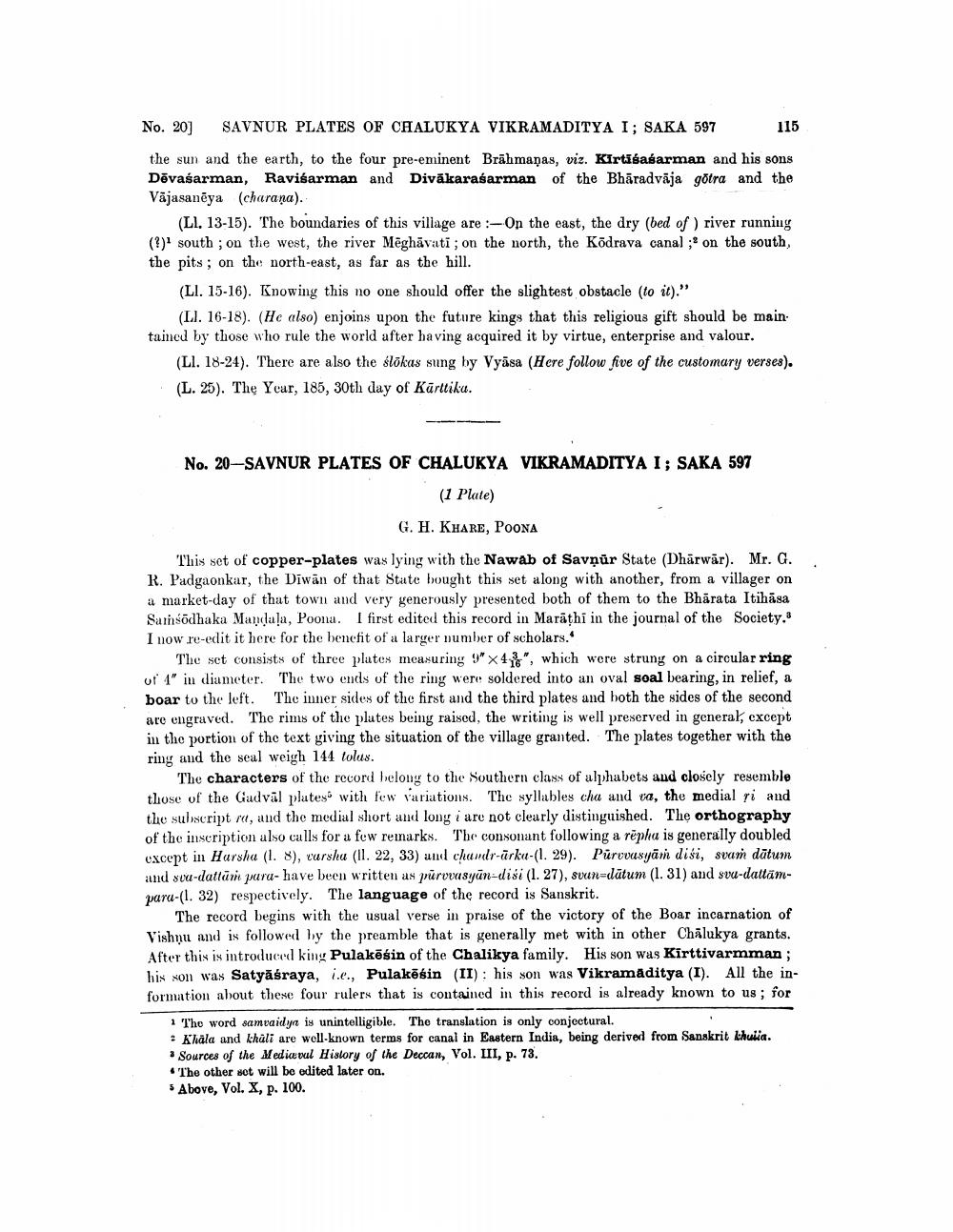________________
No. 20
SAVNUR PLATES OF CHALUKYA VIKRAMADITYA I; SAKA 597
115
the sun and the earth, to the four pre-eminent Brāhmaṇas, viz. Kirtisagarman and his sons Dēvašarman, Ravisarman and Divākaraśarman of the Bhāradvāja götra and the Vājasanēya (charana).
(Ll. 13-15). The boundaries of this village are :-On the east, the dry (bed of ) river running (?) south ; on the west, the river Mēghāvati; on the north, the Ködrava canal ;' on the south, the pits; on the north-east, as far as the hill.
(LI. 15-16). Knowing this no one should offer the slightest obstacle (to it)."
(LI. 16-18). (He also) enjoins upon the future kings that this religious gift should be main tained by those who rule the world after having acquired it by virtue, enterprise and valour.
(LI. 18-24). There are also the slökas sung by Vyāsa (Here follow five of the customary verses). (L. 25). The Year, 185, 30th day of Kārttiku.
No. 20-SAVNUR PLATES OF CHALUKYA VIKRAMADITYA I; SAKA 597
(1 Plate)
G. H. KHARE, POONA This set of copper-plates was lying with the Nawab of Savņür State (Dhārwär). Mr. G. R. Padgaonkar, the Diwan of that State bought this set along with another, from a villager on a market-day of that town and very generously presented both of them to the Bhārata Itihāsa Surnsödhaka Mandala, Poona. I first edited this record in Marathi in the journal of the Society. I now re-edit it here for the benefit of a larger number of scholars.
The set consists of three plates measuring 9" X4%", which were struny on a circular ring of A" in diameter. The two ends of the ring were soldered into an oval soal bearing, in relief, a boar to the left. The inner sides of the first and the third plates and both the sides of the second are engraved. The rims of the plutes being raised, the writing is well preserved in general, except in the portion of the text giving the situation of the village granted. The plates together with the ring and the seal weigh 144 tolus.
The characters of the record belong to the Southern class of alphabets and closely resemble those of the Gadväl plates with few variations. The syllables cha and ra, the medial ri and the subscript ra, and the medial short and long i are not clearly distinguished. The orthography of the inscription also calls for a few remarks. The consonant following a rephu is generally doubled except in Harsha (1.8), xurshu (II. 22, 33) and chandr-urku-(1. 29). Puruvusyärh disi, svam dātum and suu-dattūri paru- have been written as grūrovasyūn-disi (1. 27), svunudātum (1. 31) and svu-dattāmparu-(1. 32) respectively. The language of the record in Sanskrit.
The record begins with the usual verse in praise of the victory of the Boar incarnation of Vishnu and is followed by the preamble that is generally met with in other Chalukya grants. After this is introduced king Pulakēģin of the Chalikya family. His son was Kirttivarmman; his son was Satyāśraya, i.e., Pulakēsin (II): his son was Vikramaditya (I). All the information about these four rulers that is contained in this record is already known to us; for
1 The word samvaidyn is unintelligible. The translation is only conjectural : Khala and khali are well-known terms for canal in Eastern India, being derived from Sanskrit khuiia. * Sources of the Mediaeval History of the Deccan, Vol. III, p. 73. • The other set will be edited later on. 5 Above, Vol. X, p. 100.




